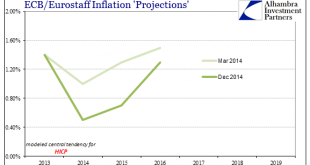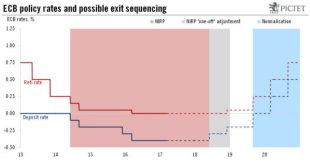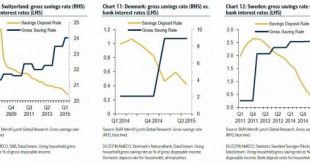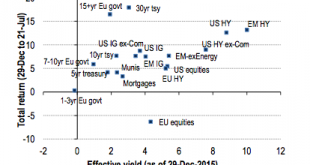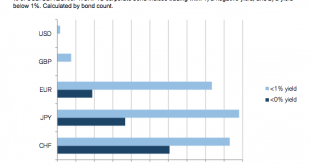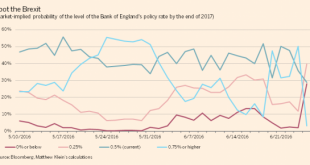Why did Mario Draghi appeal to NIRP in June 2014? After all, expectations at the time were for a strengthening recovery not just in Europe but all over the world. There were some concerns lingering over currency “irregularities” in 2013 but primarily related to EM’s and not the EU which had emerged from re-recession. The consensus at that time was full recovery not additional “stimulus.” From Bloomberg in January...
Read More »Escaping from planet NIRP
The ECB could announce further changes to its forward guidance in June as part of its exit strategy from negative rates. But we think proper rates normalisation will only start in late 2019.The debate over the ECB’s exit strategy from its negative interest rate policy (NIRP) has started in earnest. Recent comments point to a possible reversal in the exit sequencing, with a deposit rate hike preceding the end of net asset purchases.A one-off adjustment in negative rates would have some...
Read More »Canadian Bank Starts Charging Negative 0.75% Rate On Most Foreign Cash Balances
BMO Nesbitt Burns - Click to enlarge Despite speculation over the past year that Canada may join Japan and Europe in the NIRP club and launch negative interest rates, so far the BOC has stood its ground. However, starting on December 22, for the broker dealer clients of one of Canada’s most reputable financial institutions, BMO Nesbitt Burns, it will be as if the Canadian bank has cut its deposit rate on most...
Read More »Credit conditions improve in the euro area
Banks see QE and negative deposit rates as contributing to lending volumes—but also hurting their net interest income. Released on 18 October, the ECB’s third-quarter Bank Lending Survey– the first one to fully capture the effects of the 23 June Brexit referendum – remained broadly consistent with improving credit conditions. The BLS is of special significance in the current environment where commercial banks remain under a lot of pressure from all sides, whether from regulation,...
Read More »NIRP Has Failed: European Savings Rate Hits 5 Year High
One year ago, when it was still widely accepted conventional wisdom that NIRP would “work” to draw out money from savers who are loathe to collect nothing (or in some cases negative interest) from keeping their deposits at the bank, and would proceed to spend their savings, either boosting the stock market or the economy, we showed research from Bank of America demonstrating that far from promoting dis-saving, those...
Read More »Negative Yields By Rating, Sector, Country
This will be a mostly charted recap of where exactly in the rabbit hole of negative yielding corp bonds we are following last week’s knee-shaking sale of some brand new negative yielders by non-state owned Henkel and Sanofi. It was a first. It was exciting. From Morgan Stanley, with our emphasis: We estimate that a total of €467bln of EUR IG bonds now have sub-zero yields. Of this, €313bln of bonds are iBoxx...
Read More »Why Aren’t Businesses Investing?
Interest rates in developed economies have been declining for the past 40 years. At this point, 60 percent of global GDP is generated in countries that have negative or near-zero interest rates. Germany and Switzerland have both issued bonds that yield negative returns to investors, and a handful of European corporations have done the same. The yield curve has also flattened significantly in recent years, making long-term debt relatively more affordable. In other words, it’s cheaper than ever...
Read More »Return is “not really a function of yield”
When x happens, yields fall — Rule 1? It’s not a search for yield, it’s a search for safety — Potential Rule 2? Two charts to make the point for us once again from the good folks at BofAML’s relative value department: Click to enlarge. You could also pop in here and have a look at Credit Suisse’s roughly similar argument (and the state of the negatively rate inspired corporate bond market). CS’s point has to do with...
Read More »It’s a negative yielding world, we just get to scramble in it
Here’s a rough piece of calculation based on the last few years of news: When x happens, yields fall. An example of this post-GFC rule-of-thumb was Brexit and its fallout. The potential lesson from said rule is that yield hunting isn’t fun anymore, say Credit Suisse’s William Porter and team, with our emphasis: Negative (or very low) 10-year Bund yields have not been a boon for European credit markets, based on our...
Read More »Brexit and what if means for the Bank of England
“Some market and economic volatility can be expected as this process unfolds,” Carney said in a televised statement in London after the referendum result. His comments followed Prime Minister David Cameron’s announcement that he will step down this year, which will inject political uncertainty into an already volatile period. His full announcement is below and his statement can be found here: [embedded content]...
Read More » Swiss Economicblogs.org
Swiss Economicblogs.org

